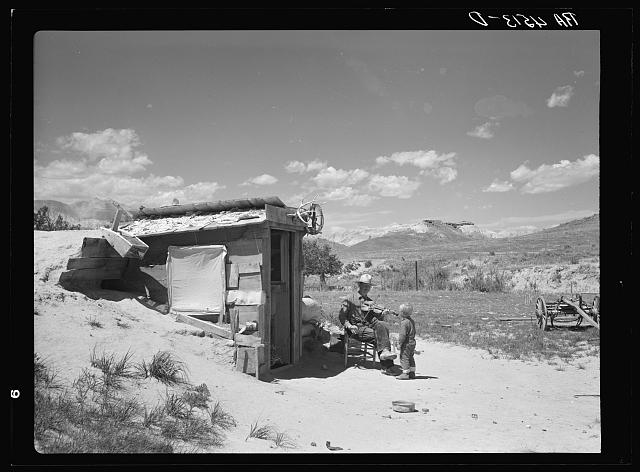The Depression-era photographer,
Arthur Rothstein, spent part of 1936 recording dust storms and their after-effects for the Farm Services Administration. His photos can now be found in the
Prints and Photos Division of the Library of Congress. Here's a sampling of them. Click to view full size. All captions are by LC staff from information supplied with the negatives.
First the dust itself:

{Heavy black clouds of dust rising over the Texas Panhandle, Texas, 1936 Mar.}

{Heavy black clouds of dust rising over the Texas Panhandle, Texas, 1936 Mar.}

{Dust storm. Note heavy metal signs blown out by wind. Amarillo, Texas, 1936 Apr.}

{Dust storm. Amarillo, Texas, 1936 Apr.}
Here are photos of the people, their dwellings, and the environment in which they attempted to survive.

{Dust is too much for this farmer's son in Cimarron County, Oklahoma, 1936 Apr.}

{Son of farmer in dust bowl area. Cimarron County, Oklahoma, 1936 Apr.}

{Farmer and sons walking in the face of a dust storm. Cimarron County, Oklahoma, 1936 Apr.*}

{Mike Sullinger, who has a farm near Carson, North Dakota, looking for rain, 1936 July.**}

{Typical farm in drought area. Beach, North Dakota, 1936 July.}

{Overgrazed land. Pennington County, South Dakota, 1936 May.***}

{Grasshoppers have destroyed this orchard on Mrs. Emma Knoll's farm in Grant County, North Dakota, 1936 July.}

{Dust bowl farmer raising fence to keep it from being buried under drifting sand. Cimarron County, Oklahoma, 1936 Apr.****}

{Dugout inhabited by farmers who have abandoned their farms and moved to town. Grassy Butte, North Dakota, 1936 July.}

{Children of submarginal farmer. Pennington County, South Dakota, 1936 May.}

{House on land development project. Pennington County, North Dakota, 1936 May.}

{Sod house in which this man's father homesteaded thirty years ago. Pennington County, South Dakota, 1936 May.}

{A Kincaider who is still proving his claim with one year to go. Pennington County, South Dakota, 1936 May.*****}

{Waiting for better times, J. Huffman of Grassy Butte, North Dakota, sits in front of his closed store, 1936 July.}

{A sod homestead built in 1900. Pennington County, South Dakota. Since 1900 this sod house has been standing to mark a farmer's effort to reap wealth from the Great Plains. At the time of its construction there must have been skirmish after skirmish with the cattlemen as the fence of the homesteader narrowed down the range. Then wartime prosperity, with the price of wheat booming. Then the years of intermittent drought, up to the present, and instead of wealth, a bitter battle to achieve mere subsistence on the parched earth, 1936 May-June.}

{Vernon Evans and family of Lemmon, South Dakota, near Missoula, Montana, Highway 10. Leaving the grasshopper-ridden and drought-stricken area for a new start in Oregon and Washington. Expect to arrive at Yakima in time for hop picking. Make about two hundred miles a day in Model T Ford. Live in tent, 1936 July.}

{Farmer of Lancaster County, Nebraska, 1936 May.}

{Construction on a stock water dam. Dawes County, Nebraska, 1936 May.}
-------------
Notes:
*This became one of the most famous images of the period. Rothstein was accused of fakery because he requested the father and sons to take the poses that you see. Such posing was ubiquitous in FSA images by virtually all its photographers and was both widely known and perfectly obvious; the photographers didn't claim otherwise. There's truly no fakery here, just the capturing of a compelling image by the discerning eye of a master photographer.
**As above, it seems irrelevant whether the photographer asked him to take this pose or he did it without prompting.
***This image became well-known when it was revealed that Rothstein had moved the skull from another place so that he could capture it in the same image with the cactus. Critics claimed that his intervention sullied the purity of the photo and invalidated the meaning that it conveys. This now seems to be an empty argument, partly for the reasons given above.
**** It was claimed that the farmer would not have used that type of shovel for post hole digging, and thus that Rothstein was again engaged in some kind of fakery. The criticism is weak (why does it matter what shovel appears?) and probably unjust as well since that was just the sort of shovel one
would pick to work with light dust.
***** A Kincaider was a farmer (men who came to be known as "sod-busters") who took advantage of the
Kinkaid Act of 1904 to claim a homestead in Nebraska.


























No comments:
Post a Comment